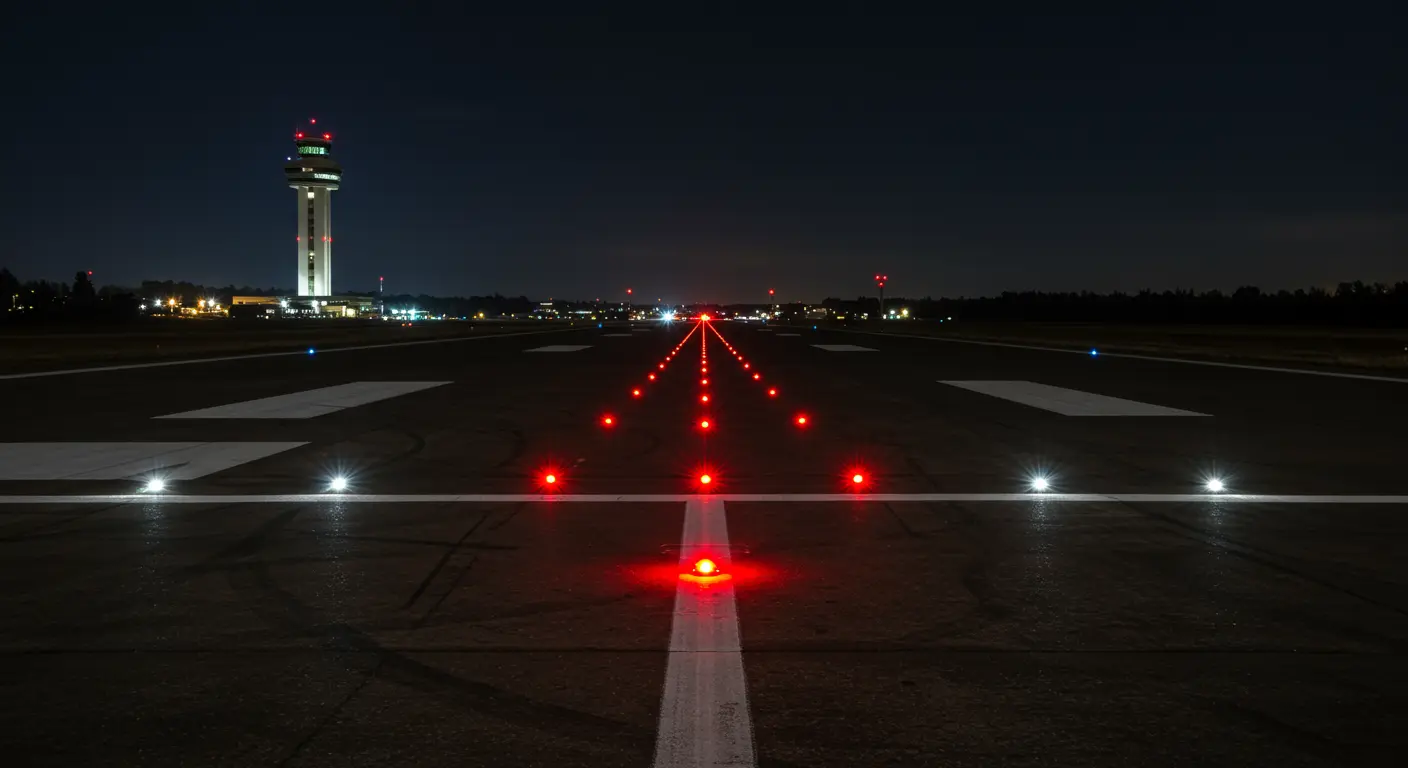The Importance of Runway Lighting at Night
When darkness falls, airport runways transform into complex networks of light—critical systems that ensure aviation safety, guiding aircraft through the night and ensuring operations never cease.
These lighting systems provide essential visual guidance for pilots during takeoff and landing. Without them, night operations would be impossible.
The control of these lighting systems is usually managed by air traffic control towers or flight service stations. At smaller airports lacking permanent staff, innovative pilot-controlled lighting systems empower aviators to activate runway lights remotely through radio transmissions—ensuring accessibility even at unmanned facilities.
Beyond mere visibility, runway lighting uses a precise visual language to pilots through standardized color codes, patterns, and intensities. This lighting system helps pilots identify runway boundaries, centerlines, approach paths, and potential hazards—all critical elements for maintaining spatial awareness when darkness naturally compromises depth perception and visual references.
Types of Runway Lights and Their Functions
-
Runway Edge Lights: These outline the landing surface, appearing white but transitioning to yellow for the final 2,000 feet of the runway.
-
Centerline Lights: Embedded in the runway’s center, these lights are white, then alternate red and white for the last 2,000 feet, and become solid red for the final 1,000 feet, providing distance cues.
-
Threshold and End Lights: Green lights mark the beginning of the usable landing surface, while Runway End Identifier Lights (Rails)—flashing white strobes—make the runway end highly visible.
-
Taxiway and Approach Lights: Blue lights line taxiway edges, and green lights mark their centerlines. Approach lighting systems extend from the runway to help pilots align for landing in low visibility.
Visual Cues for Pilots During Night Landings
Visual approach slope indicators are essential for maintaining a safe descent profile. Systems like VAST (Visual Approach Slope Indicator) and its more advanced successor, PAPI (Precision Approach Path Indicator), employ precisely angled light units that display different colors based on the aircraft’s position relative to the ideal glide path.
These slope indicators are especially important during night operations when depth perception falters. They help pilots maintain consistent descent angles and avoid dangerous approach profiles that could result in either undershooting or overshooting the runway.
Common Visual Illusions in Nighttime Flying
Night flying creates unique perceptual challenges that can create dangerous mismatches between a pilot’s sensory interpretation and reality. These visual illusions emerge primarily from the human visual system’s inherent limitations in low-light environments and can severely compromise a pilot’s ability to make accurate judgments during critical flight phases.
-
Black Hole Approach: This illusion occurs when approaching a runway over unlit terrain, causing pilots to perceive themselves as higher than they are and fly a dangerously low approach.
-
Runway Width Illusion: A wider-than-normal runway can make a pilot feel too low, leading to a high approach. A narrow runway has the opposite effect, potentially causing a low approach.
-
Vestibular Illusions: The inner ear can cause disorientation. The somatogenic illusion creates a false feeling of climbing during acceleration, while the graveyard spiral is an unrecognized banked turn that can lead to a dangerous descent.
Autokinesis presents another deceptive phenomenon where a stationary light appears to drift when stared at for extended periods. To counter these dangerous illusions, pilots must prioritize their instruments over visual cues, maintain sharp situational awareness through proper scanning techniques, and develop a thorough understanding of how these distortions manifest.
Navigating airport environments after dark requires pilots to develop specialized skills and knowledge far beyond those required for daytime operations. Thorough pre-flight preparation becomes essential at night, with particular emphasis on studying airport diagrams and mastering the specific lighting configurations at both departure and destination facilities.
Modern electronic flight bags (FBS) provide detailed, geo-referenced airport diagrams that display the aircraft’s real-time position—significantly improving situational awareness on the ground.
Communication becomes more important during night operations. Clear, precise radio exchanges with air traffic control help confirm positions and instructions, minimizing the risk of costly misunderstandings in the visually constrained nighttime environment.
Safety Tips for Night Flights
-
Pre-flight Planning: Carefully plan your flight, paying close attention to weather and identifying suitable alternate airports.
-
Equipment Preparation: Carry multiple flashlights with fresh batteries (including a headlamp) and organize cockpit materials for easy access in the dark.
-
Conservative Fuel Management: Carry at least 30–45 minutes of extra reserve fuel beyond daytime requirements.
-
Altitude Selection: Fly at higher altitudes for better obstacle clearance and gliding distance. Slightly lowering the nose after the initial climb can improve forward visibility.
-
Regular Practice: Maintain proficiency by flying at night regularly to stay comfortable with the conditions and meet FAA currency requirements.
Finding High-Quality Images of Runways at Night
-
Stock Photography Platforms: Premium sites like Shutterstock, Adobe Stock, and Getty Images offer extensive, professional aviation collections.
-
Aviation-Specific Organizations: Websites for the Aircraft Owners and Pilots Association (AOPA), flight training providers, and airport authorities frequently publish accurate, high-resolution photographs.
-
Government Media Libraries: NASA and the FAA provide copyright-free or public domain images from research and safety initiatives.
-
Social Media and Forums: Platforms like Instagram and specialized aviation forums offer unique photos from pilots and photographers, though formal use requires permission.
For better search results, employ specific keywords like “runway edge lights,” “PAPI lights,” or “airport night operations” rather than generic terms. Including “diagram” or “schematic” can help uncover valuable educational illustrations.

